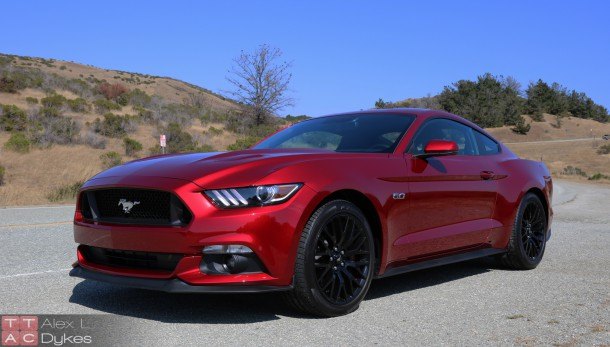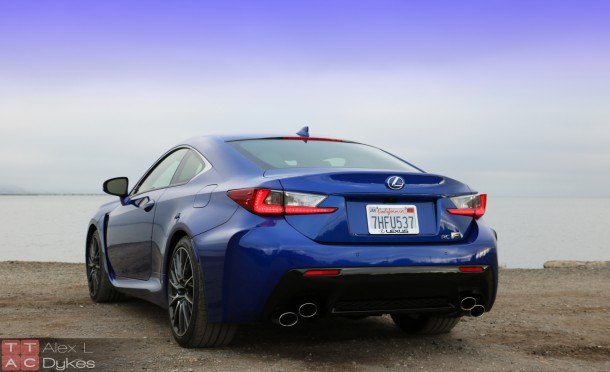#V8
2015 Ford Mustang GT Review - No Longer A One-Trick Pony (With Video)
2015 Ford Mustang GT Premium
5.0-liter, DOHC V-8, CVVT (435 horsepower @ 6,500 rpm; 400 lbs-ft @ 4,240 rpm)
6-speed Getrag MT82 manual
15 city/25 highway/19 combined (EPA Rating, MPG)
18.2 mpg (Observed, MPG)
Tested Options: GT Premium Trim, Ruby Red Paint, 401A Package, Performance Package, Adaptive Cruise Control, Navigation, Recaro Seats
Base Price:
$30,875*
As Tested:
$45,470*
* All prices include $900 destination charge.
Ford’s Mustang is as American as the hot dog and KFC Double Down, but for 2015 it received an internationally-focused makeover. Since 1964, the Mustang has been the place to find a large V8, a manual transmission and a solid rear axle. That solid axle has been a point of contention for foreign auto journalists who frequently compared the Ford’s handling to a pickup truck, and decried the GT as a one-trick pony: the car that was excellent in a straight line at a drag strip — and that was about it. That’s a problem when Ford’s new mission is greater harmony in their lineup worldwide.
While 2015 retains the large V8 engine, manual transmission and rear wheel drive we’ve all come to know and love, it brings the first completely independent suspension to every Mustang in over 50 years. Also big news for 2015 is the resurrection of a 2.3-liter four-cylinder engine, something we haven’t seen since the Fox body Mustang of the early 1990s. In a nod to our friends in Old Blighty, a factory-made right hand drive model is also in the works. All of these changes are because this Mustang is suddenly thrust into a much bigger pool of competitors.
Can Ford teach this pony some new tricks to compensate?
Piston Slap: Commandeering The Commander's Electrics?
(photo courtesy: productioncars.com)
Brett writes:
Sajeev,
Brett here. Got a weird one, or maybe it is not that weird since it involves a Chrysler product and electrical gremlins. My father drives a 2006 Jeep Commander, 5.7-liter HEMI, basically loaded. Overall, he likes the Jeep. It has about 104k miles on it. Anyways, it is his forth Jeep and he is having some weird electrical problems.
Imagine that, a Chrysler product with electrical problems…
2015 GMC Sierra Crew Cab Review - America: The Truck
2015 GMC Sierra Crew Cab SLT 4×46.2-liter OHV V-8, direct injection, cylinder deactivation, CVVT (420 horsepower @ 5,600 rpm; 460 lbs-ft @ 4,100 rpm)
Hydra-Matic 8L90 8-speed automatic
15 city/21 highway/17 combined (EPA Rating, MPG)
16.5 mpg, mostly city driving while yelling “AMERICA!” at full trot. (Observed, MPG)
Tested Options: 6.2L Ecotec3 V-8, navigation, polished exhaust tips, sunroof, spray-in bedliner.
As Tested (U.S.):
$52,300 w/ $1,195 destination charge ( sheet)
As Tested (Canada):
$59,615 w/ $1,795 destination charge and A/C tax ( sheet)
A farm, lots of mud thanks to rain from the previous day, and a dose of sunshine to dry out the ground just enough so my feet wouldn’t lose their boots in the slop. This is the perfect location — along with the perfect conditions — to test one of the latest from the pickup crop, the 2015 GMC Sierra.
Or is it?
Under the hood of the SLT-trimmed Sierra sits a V-8 less suited to farm duty and better equipped for automotive trolling.
Before we get into the meat and potatoes of the Sierra, I have a small announcement to make. TTAC now has an off-road area for testing trucks and SUVs. Sort of. It probably won’t be fully available for us for a little while, but shenanigans will be had before the end of the summer. Here’s hoping the automakers send us some metal so we can put it to the test at this newfound playland.
As for this Sierra, well, it isn’t a farm truck. Hell, it’s barely a work truck. The Sierra is available in four different trim levels — base, SLE, SLT and the top-trim Denali. Our SLT-trimmed tester arrived with its bench seat still intact, which is great for mid-summer-romance canoodling and one of the reasons girls dig guys with trucks, maybe.
Interior configuration aside, the real news for this Sierra is under the hood. The 6.2-liter Ecotec3 V-8, with its 420 horsepower and 460 pounds-feet of torque, is a nod to old-school solutions to making power and a pragmatic approach to efficiency. The pushrod V-8 might sound antiquated next to the new turbo and diesel units from Ford and Dodge, but that doesn’t make it any less valid.
2015 Lexus RC F Review (with Video) - Is F Greater Than M?
The last Lexus coupé-only model to grace luxury Japanese dealer lots was the 1991-2000 Lexus SC 300/SC 400. Since then Lexus has tried to satisfy luxury coupé and convertible shoppers simultaneously with the hardtop SC and IS convertibles since 2001.
That is until the folks in Japan decided to change their strategy to compete more directly with BMW, Mercedes and Audi in every segment. The result is the development of the RC.
Perhaps because Lexus decided against a 2-coupé strategy, as utilized by BMW and Mercedes, the RC is mix mash between the compact IS and the mid-sized GS — with a little bit of Lexus IS C tossed in for good measure.
In theory, the new coupé was also to serve as the basis for an all-new convertible. Unfortunately, the dealer network revolted and demanded another change in course, redirecting efforts into a 3-row crossover. As a result, the all-new RC is sold alongside the aging Lexus IS C convertible, a situation that’s unlikely to change for the foreseeable future. Fortunately for enthusiasts, Lexus developed their M4-fighter at the same time as the more pedestrian RC 350, otherwise the very-blue 467-horsepower RC F you see above may have met the same fate as the moribund convertible.
New V8 Supercars Rules: Smaller Engines (Maybe), More Cars (Maybe)
Guidelines for the new Australian V8 Supercar series outline specifications for its new cars, including an option to use smaller engines for the manufacturers who compete.
According to the racing series, the new platform “allows more flexibility in terms of body style and engine configuration, provided they comply with the regulations. The V8 engine, which has been mandated for more than 20 years, is also expected to continue as the dominant power plant of the sport.”
The guidelines allow for 4-, 6- or 8-cylinder engines, as long as they meet power specifications. The plans also call for a minimum noise limit of 85 to 95 dB. Take that, Bernie.
I Tried to Buy a Charger This Weekend and Failed Miserably
We just had a fight.
Scratch that. We were still having a fight. This was just the tense calm between volleys of verbal mortar fire. I won’t even tell you what we were fighting about. The subject was so stupid it would make my girlfriend and I both look like utter idiots — like those times when you shout at a character in a TV show to grow up and “just say you’re sorry already!”
Instead of doing what any rational human would do, I figured my only chance of peace was to escape the waves of relationship-drama ordnance. I grabbed the keys to this week’s Charger along with my vaporizer and fled the front line to regroup and regain my sanity.
More Corporate Average Horsepower, Hellcat Production Going Up
Nothing is more American than a high-horsepower V8 in a muscle car. Thanks to increased demand, roads are going to feature more of that familiar V8 rumble as Dodge ramps up Hellcat production.
2015 Chevrolet Silverado 2WD LT Crew Cab Reader Review
Just a couple of months ago, GM quietly announced their factory 5 year/100k mile powertrain warranty was going to henceforth be downgraded to a 60k mile powertrain warranty because their cars are all fine now and customers don’t care about long-term warranties.
About 48 hours after this was announced, my wife found herself limping along the side of a major road in our 2010 Malibu with 90k miles on the odometer, engine revving, but little transmission of power taking place between the engine and the wheels.
While You Were Sleeping: Cadillac Minuses V8 ATS-V+, Volkswagen Picks Boring Font and Ford Releases Patents Into the Wild
The ATS-V+ rumored by Motor Trend is definitely not happening according to Cadillac spokesperson David Caldwell. The proposed new model would encroach too much into CTS-V territory for comfort.
Here’s what happened overnight.
While You Were Sleeping: Cadillac ATS-V+, Holden Monza and Lamborghini Urus Receives Greenlight
This edition of While You Were Sleeping offers up a bit more than usual. Instead of just overnight, we are going to try to cover as many topics from over the long weekend as possible with additional commentary.
Here we go!
2016 Chevrolet Camaro - Same Recipe, New Ingredients
“From every angle, you’ll never mistake this for anything but a Camaro,” said Tom Peters, design director for the sixth-generation Chevrolet Camaro. That’s probably because it hasn’t changed that much, at least visually. Yet, under the skin, the new Camaro drops some 200 lbs thanks to its new Alpha platform bones and gains a new base engine – a 2.0L turbocharged Ecotec four-pot.
While You Were Sleeping: Project CARS Tomorrow, Off-Road Lowrider and the Last Commodore is Almost Here
Almost everything interesting from overnight happened in Australia. So lets talk about video games instead.
Piston Slap: Riddle Me This, Timing Chain Rattle
But wait…there is less???
Sajeev writes:
As the Christmas Spirit draws near and Pistonheads relax with thoughts of good vehicular cheer…screw it, I’ll get to the point:
Can timing chain rattle on start-up magically resolve itself after a mere tune up?
Piston Slap: Flat Plane Crankshaft Design?
My 98 booming with a trunk of funk, Don’t Believe the Hype. (photo courtesy: Ford)
GCH writes:
Sajeev:
Could you/somebody please explain what a “flat plane crankshaft” is in the new Mustang GT350, and older Porsches and Ferraris?
I have seen numerous references to it online and in print but nobody, including Wikipedia explains it in non-calculus terms.
Piston Slap: Less Slap, More (oil) Control
Pete writes:
Hey Sajeev, I got one for you.
Several engines nowadays are set up to operate on half their cylinders under light-load conditions. Would the design considerations for piston rings vary from those normally used for such cylinders that are only used part-time? The question arises in the context of a 2009 V6 Accord that is currently in the Honda dealer’s shop to have the piston rings replaced at the manufacturer’s expense to cure a continual oil consumption and spark plug fouling problem.




























Recent Comments